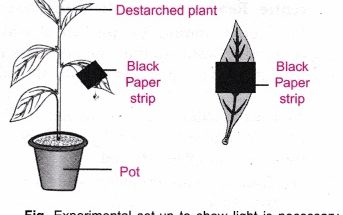In Activity 1.1- Stomatal Opening, we explore how sunlight affects a plant’s ability to perform photosynthesis. We use two potted plants of the same kind, keeping one in darkness and the other in sunlight. After a few days, we test the leaves of both plants with iodine to see if there’s starch, which indicates photosynthesis. This activity helps us understand the importance of sunlight for plants to make their food.
Key Concepts
- Photosynthesis- It’s a process where plants convert carbon dioxide and water into glucose and oxygen, using sunlight. This process primarily occurs in the leaves of the plant.
- Stomata- These are tiny openings on the surface of leaves. They play a vital role in gas exchange, allowing carbon dioxide to enter the leaf and oxygen to exit. They also help in transpiration, which is the loss of water vapour from the plant.
Also Check – Chapter 10- A Detailed Guide to “Nutrition in Plants” Activities for Class 7 Students
Procedure
- Choosing the Plants- You need two potted plants of the same kind. This is to ensure that any differences observed in the experiment are due to the treatment (light vs. dark), not the plant type.
- Environmental Setup- One plant is kept in complete darkness for 72 hours (in a black box or a dark room), and the other plant is left in sunlight.
- Performing the Iodine Test-
- After the 72-hour period, you perform an iodine test on the leaves of both plants. This test is to check for the presence of starch.
- Starch in the leaves indicates that photosynthesis has occurred, as starch is a product of this process.
- Observing and Recording Results-
- For the plant kept in sunlight, you should observe a positive result for starch presence, indicating photosynthesis occurred.
- The plant kept in darkness might show a negative result since it was not able to perform photosynthesis without light.
- Further Testing-
- The plant initially kept in the dark is then exposed to sunlight for 3-4 days and tested again with iodine.
- This step is to observe if the plant can resume photosynthesis and produce starch once it receives sunlight.
What This Activity Teaches
- The importance of sunlight for photosynthesis in plants.
- How plants use their leaves and stomata for this process.
- How to conduct a scientific test (iodine test) to observe plant processes.
Frequently Asked Questions on Stomatal Opening and Photosynthesis
Question- Why do plants need sunlight for photosynthesis?
Answer- Plants need sunlight for photosynthesis because it provides the energy required to convert carbon dioxide and water into glucose and oxygen. Sunlight is absorbed by chlorophyll, the green pigment in leaves, which then uses this energy to start the photosynthesis process.
Question- What are stomata and why are they important?
Answer- Stomata are small openings on the underside of leaves. They are important because they allow gases like carbon dioxide (needed for photosynthesis) and oxygen (a by-product of photosynthesis) to move in and out of the leaf.
Question- What would happen to a plant if it had no sunlight?
Answer- Without sunlight, a plant would not be able to perform photosynthesis. This means it would not be able to produce the glucose needed for energy and growth. Over time, the plant would become weak and eventually die.
Question- Why do we perform an iodine test on leaves in this activity?
Answer- The iodine test is used to detect the presence of starch in leaves. Starch is produced in the process of photosynthesis, so its presence indicates that photosynthesis has occurred. Comparing leaves exposed to sunlight with those kept in the dark helps us understand the role of light in this process.
Question- What does the iodine test tell us about the plant kept in the dark?
Answer- When a plant is kept in the dark and does not perform photosynthesis, the iodine test usually does not show the presence of starch. This is because, without sunlight, the plant cannot produce starch through photosynthesis.
Question- How do plants use the glucose produced in photosynthesis?
Answer- Plants use the glucose produced in photosynthesis as a source of energy for various functions like growth, repair, and respiration. They can also store glucose in the form of starch for later use.
Question- Can plants perform photosynthesis at night?
Answer- No, plants cannot perform photosynthesis at night because there is no sunlight. Photosynthesis requires light energy, which is absent during the night.
Question- What would happen if the stomata on a leaf were blocked?
Answer- If the stomata on a leaf were blocked, the leaf would not be able to exchange gases with the environment. This would prevent the plant from taking in carbon dioxide for photosynthesis and releasing oxygen, affecting the plant’s ability to produce food and survive.
Also Check – Hydrilla Experiment – Reveals the Release of Oxygen during Photosynthesis
Also Check – Rapid Revision – Class 7 Science -Chapter 1- Nutrition in Plants – Complete Notes
Also Check – Chapter 1- Nutrition in Plants -Class 7 – Detailed Notes
Also Check – Nutrition in Plants – Class 7 Questions with Answers Worksheet
Also Check – NCERT Solutions for Class 7 Science Chapter 1: Nutrition In Plants
Also Check – NCERT Exemplar Solutions- Class 7 Science – Chapter 1 – Nutrition In Plants
Also Check – What are the function of Stomata
Also Check – Class 7- Chapter 1 – Nutrition in Plants – 4 Worksheets with Answer Key
